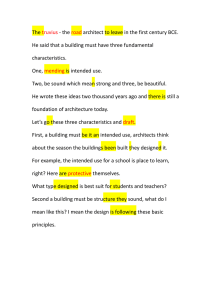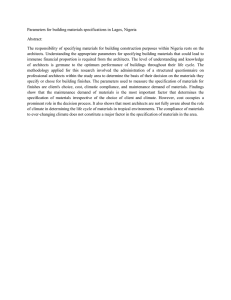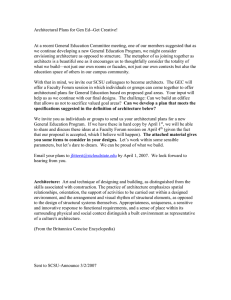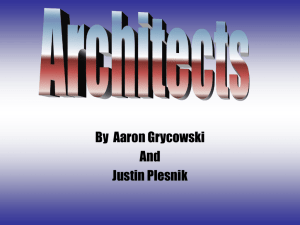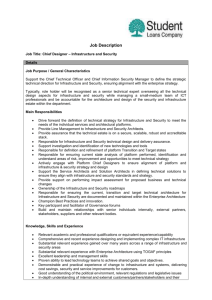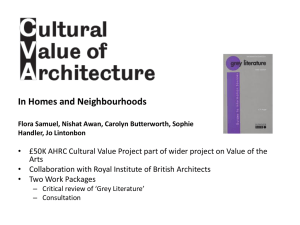Ten Points Toward Architecture
advertisement
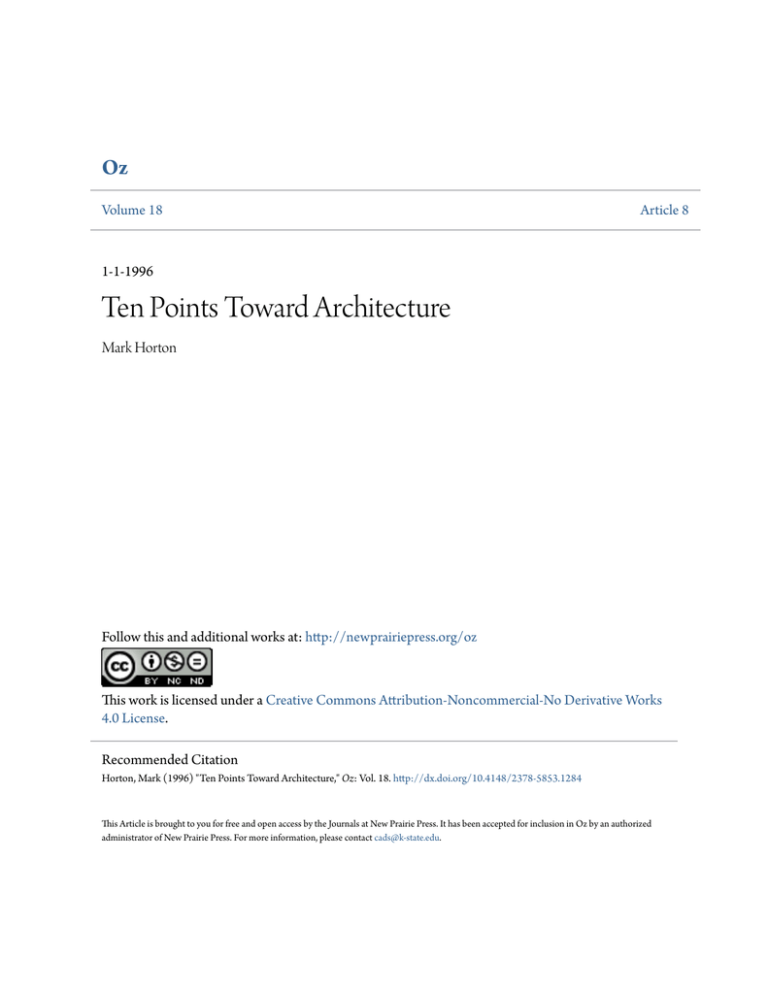
Oz Volume 18 Article 8 1-1-1996 Ten Points Toward Architecture Mark Horton Follow this and additional works at: http://newprairiepress.org/oz This work is licensed under a Creative Commons Attribution-Noncommercial-No Derivative Works 4.0 License. Recommended Citation Horton, Mark (1996) "Ten Points Toward Architecture," Oz: Vol. 18. http://dx.doi.org/10.4148/2378-5853.1284 This Article is brought to you for free and open access by the Journals at New Prairie Press. It has been accepted for inclusion in Oz by an authorized administrator of New Prairie Press. For more information, please contact cads@k-state.edu. Ten Points Toward Architecture Mark Horton Hermetic worlds entice. Between womb and grave the yearning to define a limited universe within which we exist pulls at us with a siren's call. Architects, more than most, tend to fall victim to this song. Unfortunately, the true victim is not the architect who has been consumed, but rather an unsuspecting public who is burdened with the by-product of this trap. As architects we must recognize and resist this call. We must remain part of a larger vibrant whole. Within the machinations of a small office, my work has taken many cues from a series of reminders which intermittently ground us in the real. These reminders attempt to pull us back from our co-synchronous orbit as architects into a world which is interactive with its public. These reminders are used to adjust the process and keep our purpose in focus. 36 Urban House: West Elevation 1. It's not an either/or world, it's a both/and. What one wants, to paraphrase Frampton, is a kind of critical regionalism of the mind-a resistance to the prescription of architecture as a total package; a willingness to block out certain kinds of information and desires in order to get a project done; a willingness to collect scraps of information without placing upon them the burden that they all add up to a whole. One wants texture as well as structure. 1 !1 . .Jli.L _ I - J .r~ -=c-~-- -~--- Architects are obsessed with the structure of their work; the public is much better at understanding the texture. As architects, we must attempt to come closer to the end reading-we must realize how our work is perceived and move in that direction, or we will continue to fall into the abyss of marginalizing what we do. We must step out of our singular quest to produce an architecture which fulfills our own specific and narrow goals. 2. Who's going to pay for that? The architectural avant-garde, the engineers, the politicians and the town planners have moved farther and farther apart. Their languages have become mutually incomprehensible. Once upon a time architectural theory was concerned with notions of beauty, canons of excellence, standards of technique or matters of social context. More and more it has been invaded by the idiom of cognate disciplines: esthetics, linguistics, philosophy, psychology. The result dazzles and confuses. Unless architectural criticism can get its feet back on the terra firma of good building and plain speaking, we are faced with the prospect of an endless dialogue of the deaf. 2 Urban House: Main Stair Architecture must ground itself in the world of the rational and real. The linguistic games played to elevate what at best has become a tangentially appreciated and required profession serve only to counteract any real elevation which would truly help the profession regain its pedestal and purpose in the world. We must continually remind ourselves that we are not the patrons of architecture. 37 3. Sooner rather than later. Mr. Letterman's dazed expression-by turns baffled, irritated and delightedmirrored the emotions of every New Yorker who found it nothing short of miraculous that the city still somehow worked. The mystery is not why subway cars occasionally stop dead in their tracks. It's why all the trains didn't long ago grind to a halt between stations and just stay there, leaving passengers to climb out and find their way over precarious bridges and tunnels to more civilized quarters.3 The preoccupation to produce the unique and singular must be moderated with the concern to create a world which works. The sins of narcissistic high modernism must be learned at this point; architecture must meet the demands of the everyday, and through an attempt to produce an art, elevate these to a higher but tangible, level. Architecture must strive to restore a confidence in the public that it both works and counts. 4. This is not a test. Designers say they're professional problem solvers. Here are some problems: 1. In 1991, 6,019 people were wounded or killed by gunfire in New York; 530 were children. 2. The number ofU.S. welfare recipients increased more in 1990 and 1991 than in the previous 16 years combined. 3. One of every 53 New Yorkers is infected with the HIV virus . 4. Each day some 137 species become extinct mostly because of rain forest destruction. 5. Coffee filters are often a hassle to pull apart. Which one of these looks like a designsized problem? Well, here's the solution: the One-at-aTime Coffee Filter Dispenser from Black & Decker. Design has become the profession of solving very small problems. Larger problems are left unsolved because everybody is too busy designing. 4 38 Vineyard House: East Elevation Inherent in the attempt to travel in the margin of the everyday, as a way of extracting their work from the normative, architects have cast aside the real concerns of the world for the seductive idiosyncrasies of the fringe. Exciting constructs, complex narratives, and tangential relationships create products architects enjoy, but which seldom solve problems. 5. It's the reality of a small profession. Whenever people lose power-and certainly the phenomenon of architects losing or not understanding power extends way beyond the schools-they start to create a magical language that no one else can understand, as if by hoarding the magic you could also somehow horde the power. 5 Concentric worlds orbit within our society. Those who best understand that their own world is one of many, and significantly dependent upon others, are in the best position to affect others and take advantage of potential power. Architects more often than not assume that their world is independent, and the envy, of others. This leads to a condition of a remote satellite, moving within a vast universe unaffected by, and exerting no forces upon, the surrounding galaxy. 6. We'll figure it out somehow. What is clear today and necessarily concerns us in terms of the evolution of our discipline, is that the tabula is no longer rasa. The question is no longer, as it was in the euphoria of rising industry and blossoming modernity at the dawn of this century, to invent the city of tomorrow with the aesthetic, cultural, and ethical criteria of a generation which saw progress as the driving force behind infinite possibilities. 6 Vineyard House: Entry Canopy Architects must work within the web and frame of the world within which they live. When they step outside this world they remove themselves from the position of possibly having an affect up their environment. When they operate within this world they wield great power and hold in their hands the possibility of changing people's lives. 39 7. Architecture should not be a practice of triage. .. 8. Now, how exactly are they supposed to build that? Mr. Koolhaas and O.M.A. "perceive the city as a survivor." Survivors are not victims. They have earned the right to set their own terms. Cities shouldn't be competing with the suburbs by trying to become more like them. They don't have to turn themselves into theme parks. They have better things to do than indulge the fear that their best days are behind them by encouraging architects to design new buildings that look old. 7 The architect's job, in my opinion, and I must close on this, is to find those spaces, those areas of study, where the availabil ities, not yet here, and those that are already here, can have better environments for their m aturing into those which talk and say things to you and really make evident that the spaces that yo u make that are the seat of a certain offering of man next to man. It is not an operational thing. You can leave that to the builders and to the operators. They already build eighty-five percent of the architecture, so give them another five percent if they're so stingy, so very se lfi sh about it , and take only ten percent or five percent and be really an architect and not just a professional. A professional will bury you. You'll become so comfortable. You'll become so praised, equally to someone else, th at you'll never recognize yo urself after a while. You get yourself a good business character, you can really play go lf all day and your buildings will be built anyway. But what the devil is that? What joy is there if joy is buried? I think joy is the key word in our work. It must be felt. If you don't feel joy in what you're doing, then you're not really operating. And there are miserable moments which you've got to live through. But really, joy will prevail. 8 Architecture should act as a force to raise the common denominator. Within the system, it should attempt to lift the norm. Acting on its own, without a public, architecture has no greater power than if it were to have not acted. Maintaining the status quo removes the process, or act, from the world of architecture. Architecture is a battle which must be strategically plotted. Architects should choose their fights, and enter them fiercely. To confront all battles waters down the process and product, and wears the architect thin. The power of a singular building needs to be realized by architects; this will then be cognitively translated to, and understood by, the public. Choosing battles will force a differentiation between architecture and construction. Firestorm House: Northwest Elevation 40 10. How about this idea .. . 9. Boy, this ts taking longer than I thought. If we were to be interested only in those features of our environment which are suggestive of safet y, co ziness and comfort, and not at all concerned with those which suggest danger, what sort of recipe for survival would that be? Seeking the assurance that we can handle danger by actually experiencing it is therefore a source of pleasure.9 In high school we learned that C aesar was a hero and the Romans very civilized. But if you read closer you see that Caesar killed about 30,000 people in one campaign and he burned the library at Alexandria in the course of a siege. The library's destruction was completed by the emperors Aurelian and Theodosius I. Since then I always can see and smell soldiers marching, troops movmg, when I look at Classicist columns. 10 Architecture must confront all human conditions. We live in a dynamic world which must remain open to us, and integral to our design process. Architecture which attempts to be exclusionary, which longs for single worlds, diminishes the world within it exists. Monocular architecture assumes the inability of its public to understand a more complex world. The political baggage of architecture must be considered at all turns. As architects, we must understand our constructs beyond the context of the studio. We must place ourselves within the world our work is intended to inhabit, and operate with the knowledge which this positioning affords us at hand. We must read our architecture through the eyes of those who will perceive it. The houses shown here have attempted to provide architecture within a real world. They are inhabited by real people with real needs. They have been designed in a process which has existed between the polar ends of architectural reality and theory. The production of these houses has been a process of attempting to understand the perception of the reality in advance of its existence. Firestorm House: East Elevation Notes 1. H erbert M uschamp, "Proliferations," in Thinking the Present; Recent A merican A rchitecture. 2. J. Mordaunt C rook, "Only Disconnect," a revi ew of Antho ny Vidler's Th e A rch itectural Uncanny in The New York Times Book Review. 3. H erbert Muschamp, "Somewhere, U nder the Rainbow," in The New York Times, 7 March 1993. 4. Karrie Jacobs and Tibor Kalman, "The End," in The Edge ofthe Millennium . 5. Elizabeth Padjen, MArch '78, in the "GSD News". 6. Jea n N ouvel , "On Designing," in Domus, October, 1992. 7 . H erbert Musch amp , "Rem Koolhaas's New York State of Mind," a review of O. M .A.'s show at MoMA, in The New York Times, 4 N ov. 1994. 8. Louis Kahn , "Brooklyn , New York," in Perspecta, Volume 19 . 9. Jay Appleton, landscape historian , as quoted by M r. Hildebrand in Herbert Muschamp's "Roadside Attractions to Reckon W ith," in The New Yo rk Times, 28 February 1993. 10 . Wolf Prix, in an interview entitled "Perspectives," in Progressive A rchitecture. 41
